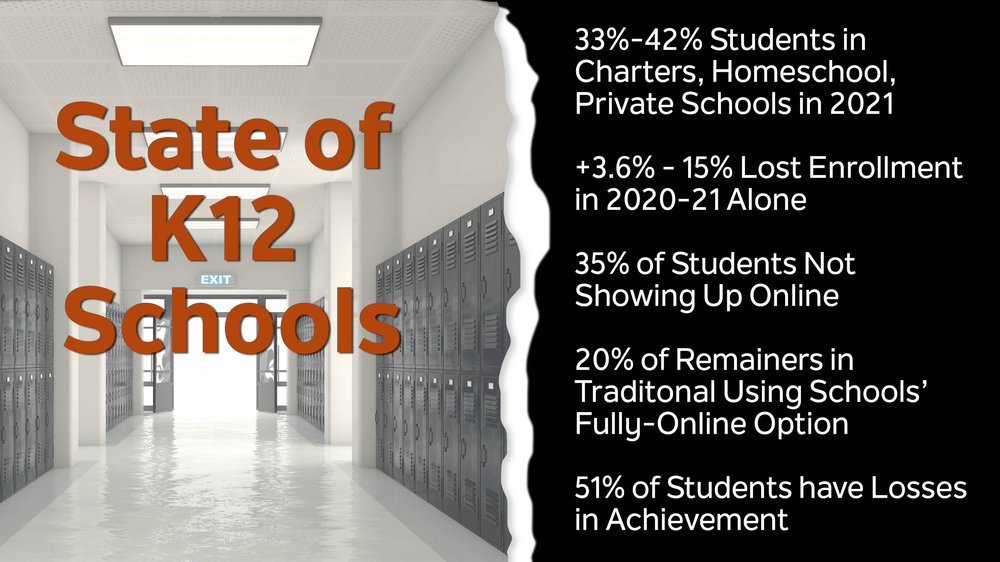We need to talk about the state of K12 schooling in America. It’s a different world now. The Learning Counsel’s major Digital Transition Survey showed our first data in October 2020 of the national scene. A new survey closed January 25th and provided an update.
Schools and districts nationwide are preparing to reopen or are already back. Pockets of resistance still abound and for good reasons, so the American landscape of “in” versus “out” is fractured. What defines “in” versus “out” has also fractured. Many students enrolled in a traditional school may not go back to the buildings because they now prefer to remain fully online. Parents and students are also asking for increasing flexibility and “in” is now defined as a few days a week, or alternating weeks, or alternating days, or just lab time or sports time now by many schools while the rest is online. This is creating a grand deviation in the norm for scheduling, staffing, and using school spaces.
Even with the relaxed definition of “in,” far fewer students are coming back to enroll in traditional public schools. The January survey shows it is worse than we thought. We have heard from educators that some of their missing students are dropouts, caught in a family need to have the high schooler watch over younger siblings. Millions of parents have had to be schooled as proxies for teachers, including how to turn on computers. Human resources and even finance personnel and the superintendents themselves in districts have been scrambled to answer phones all day and serve as hot-line computer tutorial help for millions of parents everywhere. A scant few of the students gone are the unschoolers who are totally off-grid of any school and possibly any learning at all. A handful of states do not require any parent report-in.
Instead of the national average of 3.6 percent of students not reenrolling, the data is now showing an average of 15 percent. This is in addition to the 2019 data showing 27 percent had already opted out of traditional public education. While charters, which are still public schools, are included in that mix, they are nonetheless alternatives. Some of the charters and private schools are fully online options. Some of the homeschoolers use subscription online curriculum sites that also offer support and so are almost schools.
The national exit is now somewhere between the conservative figure of 33.6 percent and 42 percent of the American K12 student body. Again, the new exits since the start of the pandemic are somewhere between the 2020 survey which we cited at 3.6 percent due to expectations of students returning, and the 15 percent of the latest survey. The rest of the 33.6 to 42 percent had already departed for alternatives by the end of 2019. These numbers are shocking only if you are not on the front lines, seeing this happening in real time.
More from the new survey:
- 35 percent of students in the traditional schools “aren’t showing up online,” in the instance where the schools are still delivering remote learning.
- 20 percent of students enrolled in the traditional schools are in the fully online option offered by that school or district.
- School leaders cite 51 percent of students have achievement loss.
In speaking with many district leaders, the losses are prompting several layers of response. The first of these has been technology and rapidly getting teachers to create digital lessons and use digital software tools to help with engagement. More advanced districts have hundreds if not thousands of curriculum software types.
Our forthcoming 2021 national survey will focus on the emerging and critical logistics issues of schools, most particularly the capacities of human teachers, tens of thousands of which are doing what is now called “simultaneous teaching.” This means they are teaching to socially distanced students in their classroom and across a video conferencing meeting at the same time.
Open-ended comments in both surveys mentioned prove that school and district leaders and their teachers are experiencing epic frustration. The data and the comments both prove that leaders and teachers have valiantly stepped up to deliver learning during quarantines despite every roadblock and the entirely altered state of this past year.
About the author

LeiLani Cauthen is the CEO and Publisher of The Learning Counsel. She is well versed in the digital content universe, software development, the adoption process, school coverage models, and helping define this century’s real change to teaching and learning. She is an author and media personality with twenty years of research, news media publishing and market leadership in the high tech, education and government industries.











